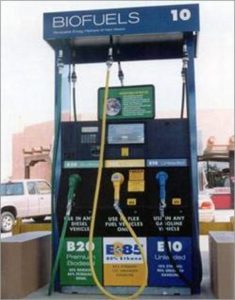Purdue University study suggests that the United States doesn’t have the infrastructure to meet the federal mandate for renewable fuel use with bioethanol, howver they could meet the standard with significant increases in next-generation and cellulosicbiofuels. Their findings were published in the December issue of the American Journal of Agricultural Economics.
The team used U.S. Department of Energy and Environmental Protection Agency data to determine that the United States is at the “blending wall,” the saturation point for ethanol use. Without new technology or a significant increase in infrastructure,they predict that the country will not be able to consume more ethanol than is being currently produced.
[ad]
The federal Renewable Fuel Standard requires an increase of renewable fuel production to 36 billion gallons PA by 2022. 13 billion gallons of renewable fuel was required for 2010, the same amount Tyner predicts is the threshold for U.S. infrastructure and consumption ability.
“There simply aren’t enough flex-fuel vehicles, which use an 85 percent ethanol blend, or E85 stations to distribute more biofuels. According to EPA estimates, flex-fuel vehicles make up 7.3 million of the 240 million vehicles on the nation’s roads. Of those, about 3 million of flex-fuel vehicle owners aren’t even aware they can use E85 fuel.”
There are only about two thousand E85 bioethanol pumps in the US, and it took more than 20 years to install them.
“Even if you could produce a whole bunch of E85, there is no way to distribute it,” Tyner said. “We would need to install about 2,000 pumps per year through 2022 to do it. You’re not going to go from 100 per year to 2,000 per year overnight. It’s just not going to happen.”
And even if the fuel could be distributed, E85 would have to be substantially cheaper than gasoline to entice consumers to use it because E85 gets lower mileage, Tyner said. If gasoline were $3 per gallon, E85 would have to be $2.34 per gallon to break even on mileage.
There is talk of increasing the maximum amount of ethanol that can be blended with gasoline for regular vehicles from 10 percent to 15 percent. But Tyner said that even if the EPA does allow it, the blending wall would be reached again in about four years.
“The advances in the production of thermo-chemical biofuels, which are created by using heat to chemically alter biomass and create fuels, would be necessary to meet the Renewable Fuel Standard. He said those fuels would be similar enough to gasoline to allow unlimited blending and would increase the amount of biofuel that could be used”
“Producing the hydrocarbons directly doesn’t have the infrastructure problems of ethanol, and there is no blend wall because you’re producing gasoline,” Tyner said. “If that comes on and works, then we get there. There is significant potential to produce drop-in hydrocarbons from cellulosic feedstocks.”
The U.S. Department of Agriculture funded the research.
Via businessgreen.com


